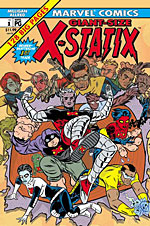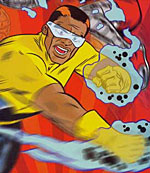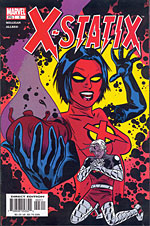>> Comment: Appointments With Disappointment
>> Comment: Accentuate The Positive?
More...

 Writer: Peter Milligan
Writer: Peter Milligan
Artist: Mike Allred, with Darwyn Cooke, Paul Pope
Colourist: Laura Allred
Letterer: Doc Allred, Nate Piekos
Collecting X-STATIX #1-5
Price: $11.99
Publisher: Marvel Entertainment Group
ISBN: 0785110593
Comics BIG BROTHER. Day One, and housemates John Byrne and Brian Micheal Bendis build an instant rapport based on their mutual love for SPIDER-WOMAN. Day Two, Dave Sim finds the inclusion of so many women contestants "pandering to a gender balance". Day Three, Grant Morrison's still untelevisable magic experiment drives Chuck Dixon partially insane. Day Four, Colleen Doran and Gail Simone gaffer-tape Sim to the Diary Room chair until he is removed from the house. Day Five, Byrne and Bendis' brief friendship breaks up over whether ULTIMATE SPIDER-MAN is actually a skrull, fight halted by Greg Rucka. Day Six, unheard of numbers of teenage girls text for Joe Casey to stay, MTV host slot already lined up. Day Seven, everything ends in tears when Bill Jemas accuses Joe Quesada of eating last pizza.
When society looks back at the twentieth century, it won't be known as the Age Of The Automobile or even the Age Of The Computer, but the TV Age. More than anything else, television shapes the way we buy, the things we talk about, the songs we hum, the people we like and the way we think. So immersed in television culture are we, we often don't even realise how much it pierces our consciousness. Even if you don't watch it, the trickle-down effect makes sure that you can't escape. Yet, its successes and failures are as nebulous and unlikely as any other form of entertainment. But when something hits, it hits hard. Reality TV being one example.
The seemingly too obvious answer that it's the unpredictability of it all that makes it so popular is missing the point. People want to know what's going to happen in their entertainment, they don't want to be surprised. That road is strewn with the husks of works of genius that were unpredictable and punished for it. It's the vicarious thrill of seeing one of us scramble up to Mount Olympus amongst the celebrity elite. The interchangeability of these 'Reality TV Stars' shows that audiences don't want new celebrities, they want real people trying to deal with celebrity.
 The volume of intelligent discourse on the subject is shallow, but luckily we have Peter Milligan.
The volume of intelligent discourse on the subject is shallow, but luckily we have Peter Milligan.
Renowned for his eccentric works like ENIGMA, SHADE or the more mainstream HUMAN TARGET, Milligan is smarter than the average commentator. His carefully chosen position on the post-modern irony scale means his work both envelops and stands apart from its target. When he's unleashed on superheroes, one can't help but look for the disdain so beloved of his English colleagues. But refreshingly, X-STATIX treats its subject matter with something approaching affection - though not reverence.
Previously known as X-FORCE, Marvel decided that a relaunch may help distance Milligan & Allred's new team from the old team's long and unnecessary history. Born from the excess of the nineties by arch-showman and hack Rob Liefeld, the title dragged its past behind it like a ball and chain all the way to the end of the century. Tasked with rejuvenating the title, Milligan and Allred tossed everything out the window and started anew. After critical and sales success, the title became X-STATIX.
Spike Freeman is a millionaire industrialist hell-bent on owning the world's most popular super-hero team. Up until recently, he had achieved that dream with the very capable - and fatality-heavy - X-STATIX. Then came O-FORCE, a poor imitation that somehow captures the public's hearts. However, O-FORCE's biggest mission to date could spell disaster for the team if X-STATIX's enigmatic leader, The Orphan, doesn't pull his team back together and save the day.
Featuring a group of simplistic, yet surprisingly fascinating characters, Milligan gives them all enough room to breath in a fairly open story-arc. Obviously the most time is given to Guy Smith, self-hating and suicidal leader of the team. But everybody from Phat to the "comedy relief" Doop get their on-panel time. Howeverm the series feels lacking after the death of lynchpin plot instigator U-Go Girl in the second collection of the same team's X-FORCE. There's nobody left who really tugs at The Orphan in the same way, something that Milligan indirectly comments on through his characters.
 The artwork by long-time self-publisher Mike Allred is some of his career best. His mixture of classical character study and pop-culture simplicity gives the characters an iconic lightness. The few times that shadow is used more starkly communicates the sense of atmosphere better than any artist who slathers their pages with blacks. His character designs are so very uniquely Allred that you can pick out those designed by his guest-conspirators.
The artwork by long-time self-publisher Mike Allred is some of his career best. His mixture of classical character study and pop-culture simplicity gives the characters an iconic lightness. The few times that shadow is used more starkly communicates the sense of atmosphere better than any artist who slathers their pages with blacks. His character designs are so very uniquely Allred that you can pick out those designed by his guest-conspirators.
Darwyn Cooke's short backup feature is surprisingly worrying, like finding a bloodied razor blade in your bag of Jelly Beans. The story of a psychological test designed to weed out the bad from the good is even more terrifying because it's the comedy relief who ends up being the scariest character. Paul Pope is called in to handle a whole issue and does so with great panache. His style segues effortlessly from Allred, and though he gets only a brief chance to demonstrate his kinetic speed-line fuelled action-sequences, it's always a welcome pleasure to see Pope's work.
The entire package feels very much like a family operation, from the lettering to the colouring. These aren't people thrown together by editorial demands, these are people who want to work together. Having had the time to work out any kinks in the partnership during their short bout on the previous volume, this collection demonstrates a perfect creative team.
A feat made even more amazing by the fact the creators have never really seen commercial success in the mainstream environment. Both Milligan and Allred have produced critically well-received works towards the edge of the industry, but never had any success this deep into company-owned superheroics. It's this unpredictability that's at the core of Milligan's work and makes him somebody to watch. And you can never predict what will be successful.

This article is Ideological Freeware. The author grants permission for its reproduction and redistribution by private individuals on condition that the author and source of the article are clearly shown, no charge is made, and the whole article is reproduced intact, including this notice.


